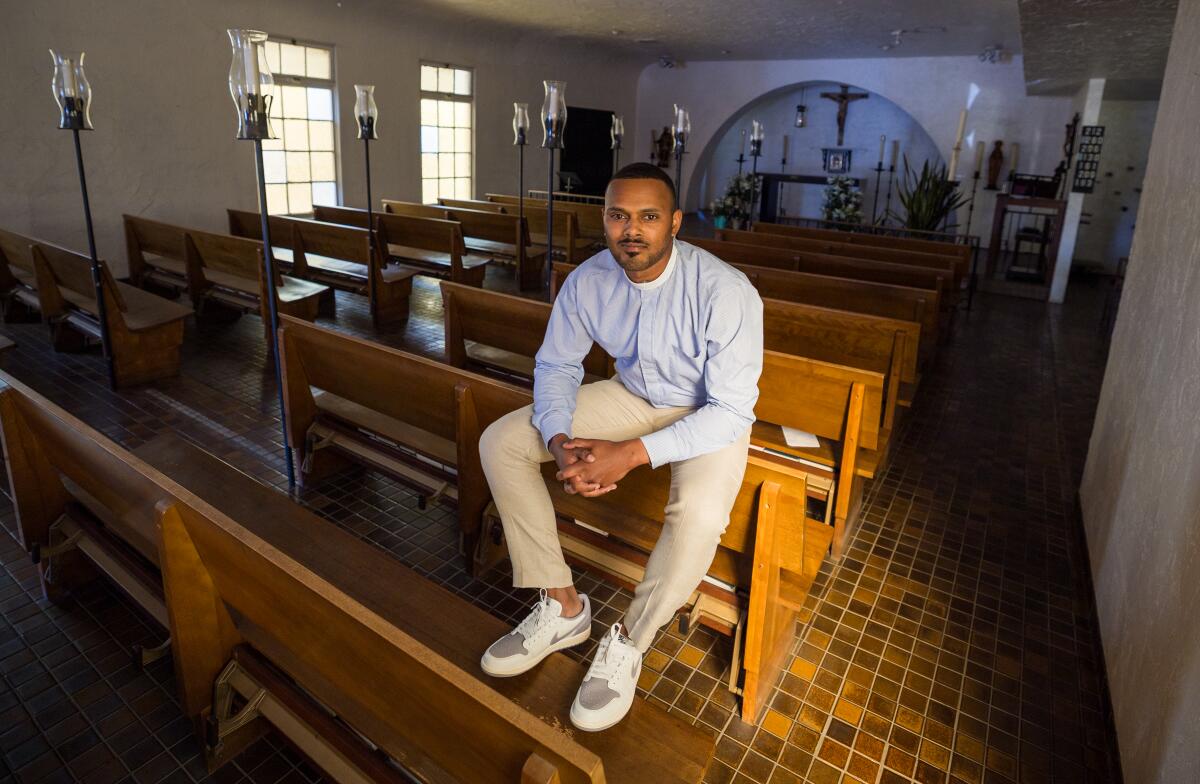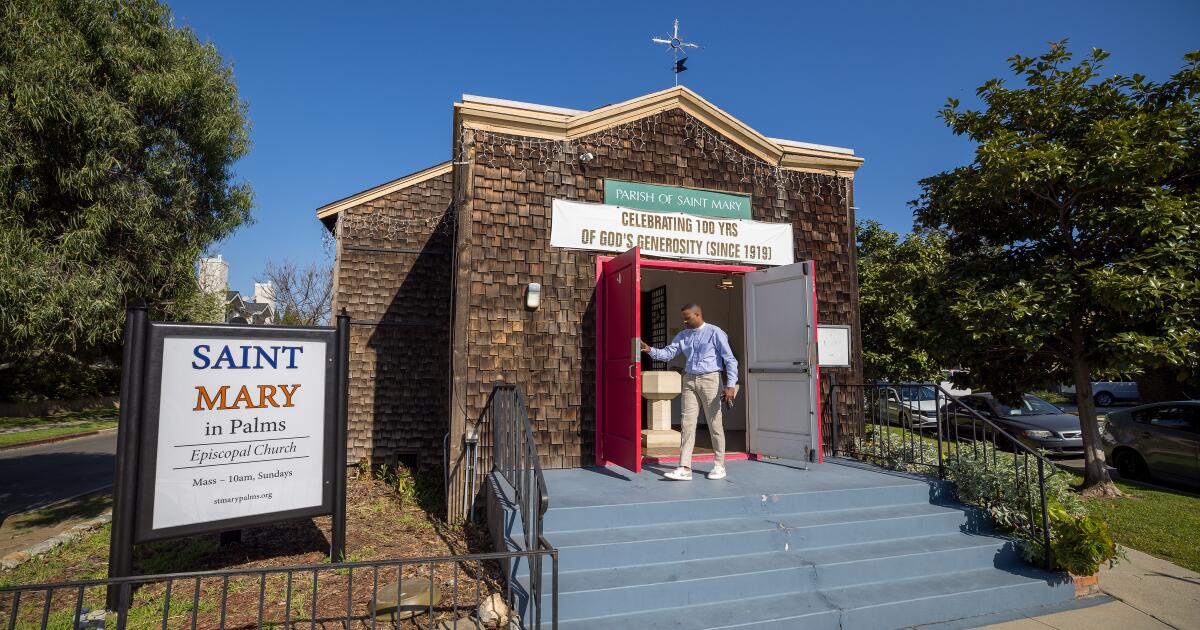The Rev. Paul Anthony Daniels knows the names and life stories of the people who sleep in their cars near St. Mary, a century-old church in Palms.
In the past, homeless people have spent the night in St. Mary’s Sunday school room.
So it wasn’t a huge leap for Daniels to think about building affordable housing on the church property.
A place to sleep, bathe and cook “provides a basic dignity” that can turn around someone’s life and also help the neighborhood, said Daniels.
“The unhoused are a part of this community,” he added. “Not only in the sense that we shelter them, but also in the sense that they live literally around the property.”
Across Los Angeles, some religious leaders are sizing up their own properties, encouraged by new legislation making it easier to develop the land.
A California law that went into effect Jan. 1 allows affordable housing projects on property owned by churches, temples, mosques and other religious institutions to bypass an extensive review process and to be built in single-family neighborhoods. The city of Los Angeles is considering even more exemptions.
An aerial view of St. Mary in Palms, center, where some of the land owned by the church may eventually be leased for affordable housing.
(Allen J. Schaben/Los Angeles Times)
In L.A., which has little vacant land, sky-high rents and a homeless population that topped 45,000 at last count, affordable housing proponents view religious institutions — often land-rich but cash-poor — as an untapped resource.
For religious leaders, building their own housing could be a way to fulfill their missions of helping needy people. And with many congregations shrinking as Americans become less religious, revenue from the developments would help make up for dwindling collection boxes.
But some real estate experts question whether many religious organizations will ultimately seek to build, considering the buy-in required from their members and governing boards. Years of construction near their sanctuaries could be a deterrent, as could opposition from neighbors.
Some cities, including Chino, Rancho Palos Verdes, Santa Clarita and Thousand Oaks, opposed the new state law as it was being debated in Sacramento. Then-Beverly Hills Mayor Lili Bosse said it would strip local governments of their power to control development, “overriding carefully crafted, locally informed plans.”
Leaders at St. Mary, an Episcopal church in the Anglo-Catholic tradition, are in the early stages of studying the idea. The small congregation is close-knit, with a few dozen people attending a typical Sunday service in the diminutive, brown-shingled church. An affordable housing project would enrich church coffers, probably through leasing fees paid by the developer.
The St. Mary property includes two main buildings, a house and six parking spaces on a narrow strip of land in a neighborhood of apartment buildings. Daniels, who has led St. Mary since 2022, said it’s too soon to say where on the property the new housing would go.

The Rev. Paul Anthony Daniels, the rector of St. Mary in Palms.
(Allen J. Schaben/Los Angeles Times)
In South Los Angeles, with its abundance of historically Black churches, many congregations are still reeling from the pandemic and a decline in attendance.
Regina Fair, a board member at Bethel AME-Los Angeles, said her church draws a few hundred people on Sundays but has cut back to a single sermon.
Like other churches, Bethel AME, which was founded in 1921, relied on livestreaming during the pandemic lockdown and uses social media to reach younger people. That all means fewer dollars in the collection plate.
“People became OK with doing church in their home, on their couch,” Fair said. “And when you’re not in the church, it makes a big impact on the giving.”
Bethel AME, which faces a stretch of South Western Avenue lined with businesses and apartment buildings, has embarked on a multiyear plan to develop affordable housing on its parking lot.
The 53-unit project, which benefited from city rules intended to fast-track affordable housing, will cater to some of the homeless men who sleep in the church on cots during the winter. The church also plans to build housing on two nearby parcels it owns.
Logos Faith Housing, which is co-developing the property, was started by a pastor to help churches build affordable housing. Bethel is leasing the land to a collection of backers in what the church’s leader, the Rev. Kelvin T. Calloway, describes as a “perfect model” to bring in revenue over a long period.
Calloway has seen gentrification change other neighborhoods in South L.A., leaving fewer worshipers in church pews. That isn’t happening much yet in Bethel AME’s neighborhood of Manchester Square, but “it’s a real possibility,” he said.

Pastor Martin Porter, managing partner of Logos Faith Development LLC, a real estate development company focused on partnering with religious entities, on the parking lot of Bethel AME Church in Los Angeles.
(Myung J. Chun/Los Angeles Times)
“Christianity is in crisis,” said Logos founder Pastor Martin Porter, who leads Quinn African Methodist Episcopal in Moreno Valley. “You’re seeing a lot of empty pews. The natural question is: What do we do with excess property that’s not being used?”
Bethel AME didn’t need the new state law, sponsored by state Sen. Scott Wiener (D-San Francisco), to develop its property.
But in L.A., at least 600 sites owned by faith-based groups in single-family neighborhoods are now eligible to build affordable housing, according to the city Planning Department. City officials couldn’t provide information about whether any applications have been filed under the law in the last eight months.
Wiener predicted it will take a few years for a substantial number of projects to launch — particularly as religious institutions figure out how to approach the opportunity.
“They’re typically not major financial players,” he told The Times. “They’re a church or synagogue, not a development company.”
“This is a big deal,” said Pastor John Oh, project manager of faith in housing at L.A. Voice, a community organization that supported the law.
Oh sees it as a potential “domino” that could lead to more zoning changes in single-family neighborhoods, which have long been treated by political leaders as off-limits for multi-unit development.
The city of L.A.’s planning department has put forward a version that, unlike Wiener’s law, does not require paying construction workers prevailing wages, or, on larger projects, providing them with healthcare.
The proposal, which is expected to come before the City Council in the next six months, is meant to appease affordable housing developers who say that the higher wages and benefits can add 30% to their costs.
Labor unions, including the United Brotherhood of Carpenters, are opposed.
Pete Rodriguez, the brotherhood’s western district vice president, called the proposal “outrageous” and suggested it could worsen the homelessness crisis by impoverishing workers.
“When will the city of L.A. realize that so many of our problems, from homelessness to budget deficits, are caused by the simple fact that too many Angelenos cannot make ends meet?” he said.
Wiener declined to comment on the city’s proposal. He said his law prioritizes protections for construction workers, who can be targets of wage theft.
Some development experts privately question whether religious entities in single-family neighborhoods will want to build affordable housing, in the face of possible resistance.
In Laguna Beach, some residents are protesting a church’s plans to build affordable housing under Wiener’s law. A petition against the development on the property of Neighborhood Congregational Church has collected about 1,500 signatures.
“It affects the entire community by altering the neighborhood’s character and exacerbating existing issues such as traffic congestion and parking shortages,” the petition said.
But Bishop Lovester Adams, who heads Greater New St. Matthew Missionary Baptist Church in a single-family residential area in South L.A., isn’t shying away. He called Wiener’s law and the city proposal “a game changer.”
Adams, who is also a senior associate at Logos Development, said he can’t afford to build housing on his church’s parking lot at 36th and Crawford streets unless the city passes the labor exemption.
The church, which dates to the 1960s, is nestled between homes and duplexes. Church leaders regularly give out food and toys to needy residents.
Attendance has fallen since the pandemic, Adams said. Sunday services draw 50 to 70 people, who fill fewer than half the seats. Some older people stay away because of concerns about COVID-19.
Adams said he wants veterans to live in the new housing: “There is a great need there.”

IKAR CEO Melissa Balaban stands in the foundation’s parking lot where affordable housing will be developed in Los Angeles.
(Genaro Molina/Los Angeles Times)
On South Fairfax Avenue in Mid-Wilshire, the Jewish congregation IKAR is building an affordable housing complex for formerly homeless senior citizens on its parking lot.
The project was built through Mayor Karen Bass’ Executive Directive 1, which fast-tracks affordable housing, said IKAR executive director Melissa Balaban. State legislation pushed by IKAR reduced the amount of required parking.
Balaban said IKAR isn’t relying on the project, which is being funded by a nonprofit developer, to generate revenue for the congregation.
“My hope is that what we’re doing isn’t just going to provide 60 homes but hopefully inspire other faith-based communities,” she said.
In Palms, St. Mary member Julia Bergstrom, 72, is enthusiastic about the idea of affordable housing on the church property.
She has noticed the number of people living in RVs rise and fall, and she finds the years-long wait for Section 8 housing vouchers to be “immoral.”
While she worries about changes to the “very beautiful little church” she has attended since 2008, “it doesn’t stop me, and it doesn’t make me sad about the whole thing,” she said.
